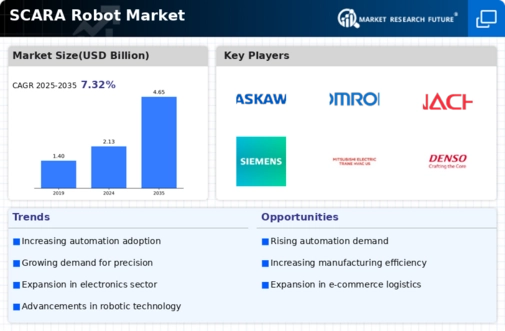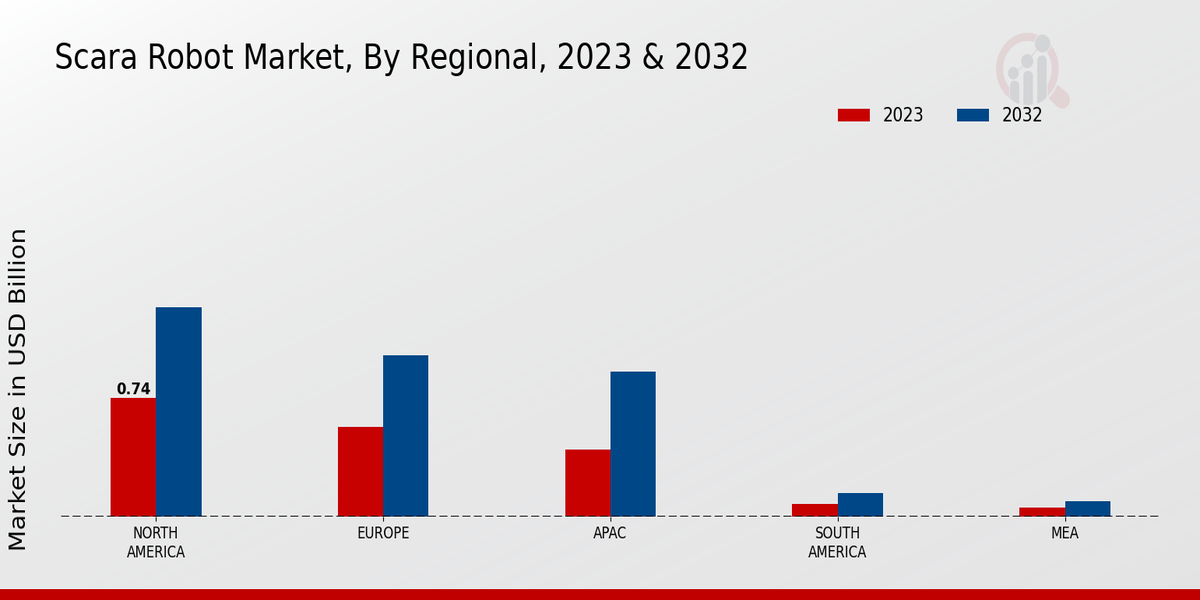Market Growth Projections
The Global SCARA Robot Market Industry is projected to experience substantial growth over the next decade. With a market size of 2.13 USD Billion in 2024, it is expected to reach approximately 4.65 USD Billion by 2035. This growth trajectory indicates a robust demand for SCARA robots across various sectors, driven by factors such as automation, precision, and cost reduction. The anticipated CAGR of 7.35% from 2025 to 2035 further emphasizes the market's potential as industries increasingly adopt these advanced robotic solutions. This upward trend suggests a promising future for the SCARA robot market on a global scale.
Growth in E-commerce and Logistics
The Global SCARA Robot Market Industry is also being propelled by the growth in e-commerce and logistics sectors. As online shopping continues to rise, companies are investing in automation to streamline their warehousing and distribution processes. SCARA robots are particularly effective in sorting, packing, and shipping products, which enhances operational efficiency. This trend is likely to drive significant market growth, as businesses seek to meet increasing consumer demands for faster delivery times. The anticipated increase in market size from 2.13 USD Billion in 2024 to 4.65 USD Billion by 2035 underscores the importance of automation in the logistics sector.
Focus on Reducing Operational Costs
The Global SCARA Robot Market Industry is influenced by the growing focus on reducing operational costs across various sectors. Companies are increasingly recognizing that investing in SCARA robots can lead to substantial long-term savings by minimizing labor costs and reducing errors in production. This economic incentive is driving the adoption of SCARA robots, particularly in industries where labor costs are high. As organizations strive to enhance their profit margins, the integration of SCARA robots is becoming a strategic priority. The expected CAGR of 7.35% from 2025 to 2035 reflects the market's potential as businesses seek cost-effective automation solutions.
Increasing Automation in Manufacturing
The Global SCARA Robot Market Industry is experiencing a surge in demand due to the increasing automation in manufacturing processes. Industries are increasingly adopting SCARA robots for tasks such as assembly, packaging, and material handling, which enhances productivity and reduces labor costs. In 2024, the market is projected to reach 2.13 USD Billion, reflecting the growing reliance on automated solutions. This trend is particularly evident in sectors like electronics and automotive, where precision and speed are paramount. As manufacturers seek to optimize operations, the integration of SCARA robots is likely to become more prevalent, driving market growth.
Technological Advancements in Robotics
The Global SCARA Robot Market Industry is benefiting from rapid technological advancements in robotics. Innovations such as improved sensors, artificial intelligence, and machine learning are enhancing the capabilities of SCARA robots, allowing for more complex tasks and greater adaptability in various environments. These advancements are making SCARA robots more accessible and cost-effective for small and medium-sized enterprises, which are increasingly adopting automation solutions. The projected CAGR of 7.35% from 2025 to 2035 suggests that the market will continue to expand as technology evolves, enabling broader applications across diverse industries.
Rising Demand for Precision and Quality
The Global SCARA Robot Market Industry is significantly influenced by the rising demand for precision and quality in production processes. SCARA robots are known for their high accuracy and repeatability, making them ideal for tasks that require meticulous attention to detail. Industries such as pharmaceuticals and electronics are increasingly utilizing these robots to ensure product quality and compliance with stringent regulations. This trend is expected to contribute to the market's growth, as companies prioritize quality assurance. The anticipated growth from 2.13 USD Billion in 2024 to 4.65 USD Billion by 2035 indicates a robust market trajectory driven by these quality demands.














